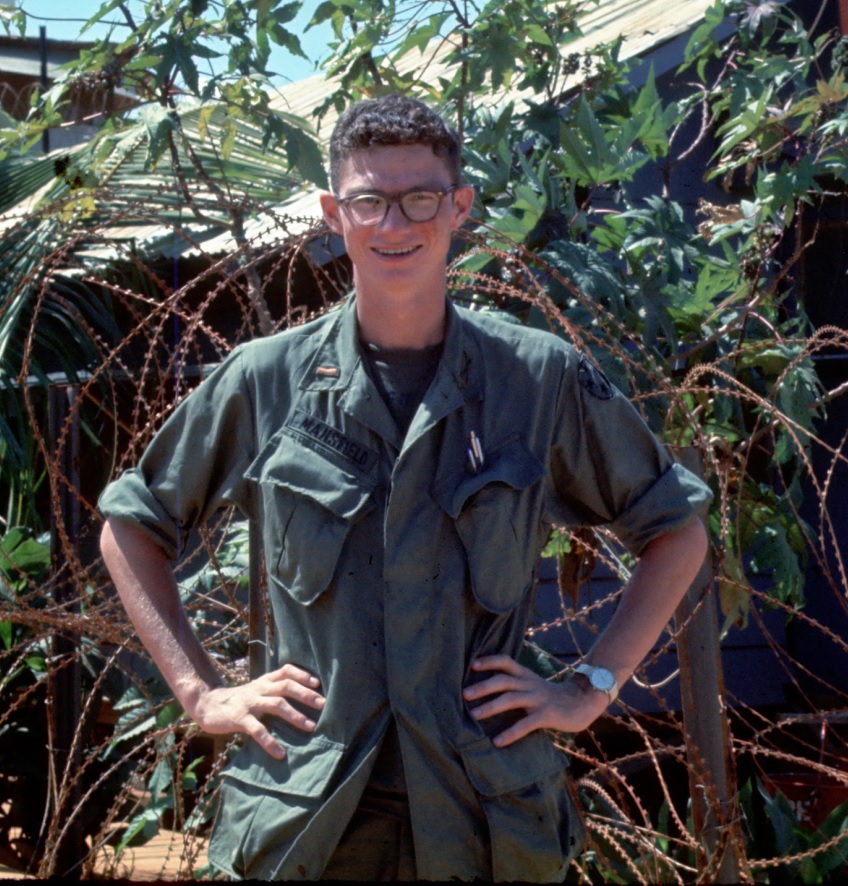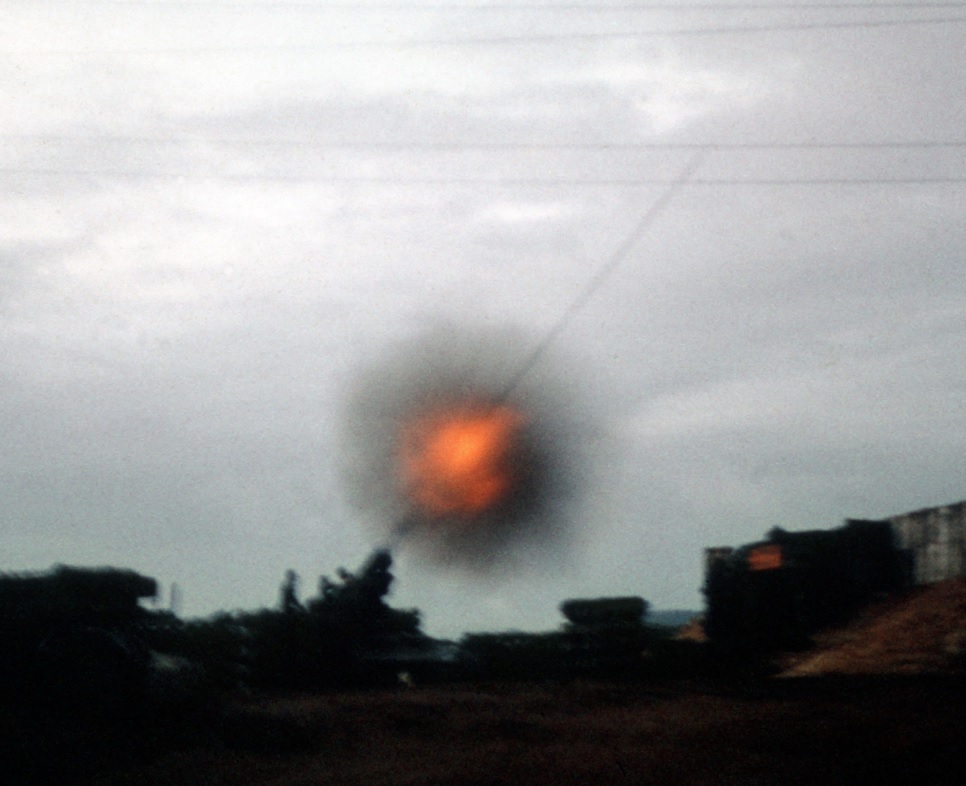
Analysis
Dr. Edward Mansfield, also known as Edd, was an interesting interview. He retired from the University of Alabama where he was a professor of statistics for several decades. He very kindly invited me into his home and to sit at his kitchen table to do the interview. He provided me with a disc of pictures that he had put together of his time in Vietnam. We spent the better part of two hours together as we spoke about his career in the U.S. Army and his life after Vietnam.
Then-Lt. Mansfield was an artillery officer during the war. He coordinated fire on targets, supplying fire support for infantry and other tactical targets.
Fragging
To put some things in perspective, Dr. Mansfield refers to an event called “fragging.” “Fragging,” taken from fragmentation grenade, was the term used when referring to a soldier using a grenade to kill a superior officer. Using a frag grenade proved to be efficient, as it would leave no evidence. The shell of the weapon was destroyed, therefore leaving behind no fingerprints. Grenades were also not given unique serial numbers, so it, in effect, could not be traced to the owner.
Fragging could have been used as retaliation for disciplinary action although also potentially used for worried soldiers to get rid of a seemingly incompetent officer, in a sort of act of self-preservation.
Virtually all fraggings or attempted fraggings did not happen on the battlefield, but in rear areas, away from the dangers of combat. There were several motivations attributed to this phenomenon. First, Defense Secretary Robert McNamara’s Project 100,000, a program to recruit soldiers who would previously have been below mental or medical standards, permitted the induction of young men who previously would have been rejected for military service because of their failure to meet intelligence standards, and who were less adaptable and more likely to have psychiatric problems. Second, the degradation of a professional junior NCO corps caused a crisis in small-unit leadership, in that these inexperienced leaders were overly permissive, sought popularity with their subordinates, and failed to correct discipline. Third, illegal drug use and alcohol abuse were factors, as they impaired judgment and lowered inhibitions, contributing to violence against fellow soldiers. While Vietnam vets argue over whether the abuse of illegal drugs and alcohol were a cause or consequence of the overall breakdown in discipline, it is still apparent that this contributed to the fragging phenomenon.
The total number of incidents of fragging during America’s involvement in Vietnam is difficult to quantify. no records were kept of such incidents before 1969, although many incidents before this date are known. It is estimated that the number of known and suspected incidents between 1969 to 1972 totaled about 900 with 99 deaths and many more injured. This is an incomplete total as some cases went unreported. Most of the victims were officers or non-commissioned officers.
Dr. Mansfield speaks about the fragging of a Captain Schneider in my interview with him. I was able to pull up an account of the event on historynet.com. Captain Scott Edward Schneider was 25-years-old and a commander of the U.S. Army artillery battery in Quang Ngai. He was described as a “good guy” – competent in his leadership and fair in his discipline. At 1:40 am on Aug 17, 1970, while he was sleeping, a fellow American threw a grenade into his quarters. The explosion killed him instantly. The Army eventually charged one of his own men, Pvt. David K. Locklin, with his murder.
Enlisted men who had worked with Locklin described him as a “druggie.” He was 19 years old and had been a heavy user of hashish, LSD, and methamphetamines before arriving in Vietnam. Once arriving in-country, his drug use expanded to daily consumption of an entire 6-ounce bottle of the liquid amphetamine Obesitol.
His drug use and frequent absences prompted Schneider to demote him three grades from Specialist (E-4) to Private (E-1). At his court-martial Locklin pleaded guilty to unpremeditated murder, was sentenced to 25 years of hard labor, and was released in 1979, having served just eight years and seven months.
PTSD
Dr. Mansfield speaks a bit about post-traumatic stress disorder (PTSD). Over 800,000 Vietnam veterans suffer from problems related to PTSD. It is characterized by intrusive, repetitive thoughts of memories related to war trauma; avoidance and denial of these memories and the emotions that they trigger; and symptoms of increased arousal, such as irritability, hypervigilance, and angry outbursts. Additional problems, such as drug and alcohol abuse, difficulty achieving and maintaining interpersonal relationships, poor occupational history, and depression. The treatment for PTSD usually consists of pharmacotherapy with anti-anxiety and/or antidepressant medications, family counseling and social support, and psychotherapy.
While Dr. Mansfield did not go too deeply into his symptoms, and as I did not want to press on such a sensitive topic, he did state that he was not difficult to manage, at least relative to others. We so often imagine those soldiers that have PTSD were the ones who came under direct enemy fire. While Dr. Mansfield did not, he did have to deal with the everyday stresses of being in combat, and the fragging of Captain Schneider, which happened mere days before he left Vietnam. Dr, Mansfield did briefly describe his difficulty and immediately adjusting to civilian and student life upon his return.
My Lai
Dr. Mansfield spoke briefly about the My Lai massacre in our conversation. This terrible event occurred on March 16, 1968, a full year before Dr. Mansfield arrived in Vietnam. On that day, a company of American soldiers brutally killed most of the people including women, children and old men, in the village of My Lai, which was roughly 9 miles from Chu Lai. More than 500 people were slaughtered including young girls and women who were raped and mutilated before being killed. The U.S. Army attempted to cover up this event for a year before it was reported in the American press. This caused an international outrage which fueled anti-war sentiment.
For Dr. Mansfield and other artillery units, once the My Lai Massacre came to light, it changed the operating procedures for artillery support of infantry units. This translated into more caution and analysis of fire trajectories higher up the chain. This came to mean that infantry units calling in for support would sometimes have to wait for up to 45 minutes before that support came.
Honor Flight
Even though this year will mark the 50th since Dr. Mansfield first arrived in Vietnam, it is clear that the war stays with him. He takes part in the Rotary Club of Tuscaloosa’s Honor Flights, which take Vietnam Vets to Washington D.C. to see the Vietnam Memorial at no cost. Dr. Mansfield acts as a “guardian” at these events, helping and looking after the vets that take these trips.
Further Readings
Borch, Fred L., and George Lepre. Army History, no. 84 (2012): 42-43. http://www.jstor.org.libdata.lib.ua.edu/stable/26298823.
Lepre, George. Fragging: Why U.S. Soldiers Assaulted Their Officers in Vietnam. Lubbock, TX: Texas Tech University Press, 2011.
Barrett, Claire, and Claire Barrett. “Murder in Vietnam.” HistoryNet. February 12, 2019. Accessed April 17, 2019. https://www.historynet.com/murder-in-vietnam.htm.
Kanas, Nick, Frank Schoenfeld, Charles R. Marmar, Daniel S. Weiss, and Paul Koller. “PROCESS AND CONTENT IN A LONG-TERM PTSD THERAPY GROUP FOR VIETNAM VETERANS.” Group 18, no. 2 (1994): 78-88. http://www.jstor.org.libdata.lib.ua.edu/stable/41718753
Jones, Howard. My Lai: Vietnam, 1968, and the Descent into Darkness. Oxford Univ Press US, 2019.
